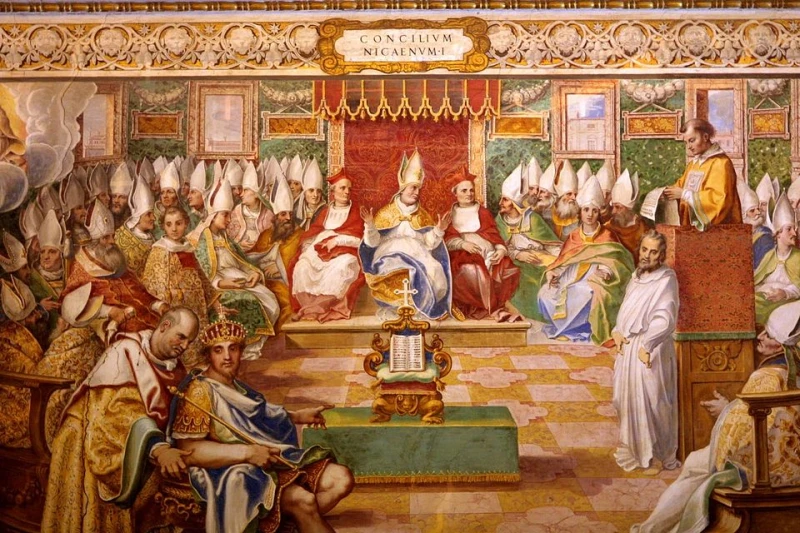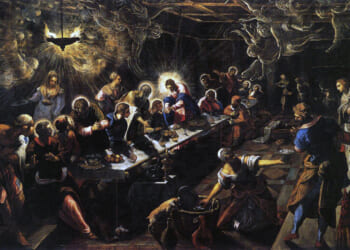
Washington, D.C. Newsroom, Jun 5, 2025 / 08:00 am (CNA).
In the summer of A.D. 325, more than 300 bishops gathered in Nicaea — located in modern-day northern Turkey — to promulgate a common Christian creed, settle Christological disputes that arose from the Arian heresy, and promote unity in the Church.
The first ecumenical council, known as the Council of Nicaea, is still accepted as authoritative by the Catholic Church, the Eastern Orthodox Church, and many Protestant denominations. The common beliefs still offer a strong element of unity in an otherwise fractured Christianity 1,700 years later.
During the council, the bishops established the initial formulation of the Nicene Creed, which is the profession of faith still recited at the Catholic Mass, Orthodox liturgies, and some Protestant services. It also rejected heretical Arian claims that Christ was a created being who lacked an eternal divine nature and rather confirmed that the Son is eternally begotten of the Father.
The council was called by Emperor Constantine — a convert to Christianity — less than 15 years after the empire halted the persecution of Christians and granted them the freedom to worship. It came just 20 years after the reign of Emperor Diocletian, who brutally persecuted Christians for their rejection of paganism.
“That council represents a fundamental stage in the development of the creed shared by all the Churches and ecclesial communities,” Pope Leo XIV said two weeks ago, acknowledging the 1,700th anniversary.
“While we are on the path towards the reestablishment of full communion among all Christians, we recognize that this unity can only be unity in faith,” the pontiff said.
The Arian heresy
The primary purpose of the council was to settle a major question about Christ’s divine nature and address Arianism, which was a heresy promoted by the priest Arius asserting that Jesus Christ was a created being and not eternal.
“Arius began to preach something that was scandalous to many Christian believers and [which] seemed incompatible to the Christian faith as witnessed to in Scripture and transmitted through the tradition of the Church,” Dominican Father Dominic Legge, the director of the Thomistic Institute and professor of theology, told CNA.
Arius wrote in “Thalia” that he believed the Father “made the Son” and “produced him as a son for himself by begetting him.” He wrote that “the Son was not always [in existence], for he was not [in existence] before his generation.” He asserted that Christ was not eternal but “came into existence by the Father’s will.” Arius contested that Christ “is not true God” but was rather “made God by participation.”
Legge said that Arius understood that “there’s an infinite gap between God and creatures,” but where he was mistaken was that “he thought that the Son was on the ‘creature’ side of that gap” and “not equal in divinity to God.”
“Therefore, he considered him to be the highest creature,” Legge added. “The first creature, but nonetheless a creature.”
Legge said that at Nicaea there was “a consensus of bishops with very different approaches to the mystery of God and they could see that Arius had to be wrong and so they condemned him and they affirmed that the Son is ‘God from God, true God from true God.’”
The language adopted at Nicaea expressly contradicted Arius, affirming Christ is “true God from true God, begotten not made, of one substance with the Father.” It condemned Arius’ view as heresy. The vote was nearly unanimous with more than 300 bishops voting in favor of this text and only two siding with Arius.
St. Athanasius, one of the most outspoken opponents of Arianism at the council and in its aftermath, wrote in his First Discourse Against the Arians in the mid-fourth century that “the Scriptures declare the Son’s eternity.”
Athanasius notes, for example, the Gospel of St. John states that “in the beginning was the Word, and the Word was with God, and the Word was God.” He also cites Chapter 8 of the same Gospel in which Christ declares “before Abraham was, I am,” invoking the divine name used by God to indicate his eternity when appearing to Moses as the burning bush.
“The Lord himself says, ‘I am the Truth,’ not ‘I became the Truth,’ but always, ‘I am — I am the Shepherd — I am the Light‘ — and again, ‘Call me not, Lord and Master? And you call me well, for so I am,‘” Athanasius wrote. “Who, hearing such language from God, and the Wisdom, and Word of the Father, speaking of himself, will any longer hesitate about the truth, and not immediately believe that in the phrase ‘I am,‘ is signified that the Son is eternal and without beginning?”
Legge noted that Athanasius also warned that Arius’ position “threatened the central truth of Christianity that God became man for our salvation.”
Unifying the Church in the fourth century
Prior to the Council of Nicaea, bishops in the Church held many synods and councils to settle disputes that arose within Christianity.
This includes the Council of Jerusalem, which was an apostolic council detailed in Acts 15, and many local councils that did not represent the entire Church. Regional councils “have a kind of binding authority — but they’re not global,” according to Thomas Clemmons, a professor of Church history at The Catholic University of America.
When the Roman Empire halted its Christian persecution and Emperor Constantine converted to the faith, this allowed “the opportunity to have a more broad, ecumenical council,” Clemmons told CNA. Constantine embraced Christianity more than a decade before the council, though he was not actually baptized until moments before his death in A.D. 337.
Constantine saw a need for “a certain sense of unity,” he said, at a time with theological disputes, debates about the date of Easter, conflicts about episcopal jurisdictions, and canon law questions.
“His role was to unify and to have [those] other issues worked out,” Clemmons said.
The pursuit of unity helped produce the Nicene Creed, which Clemmons said “helps to clarify what more familiar scriptural language doesn’t.”
Neither the council nor the creed was universally adopted immediately. Clemmons noted that it was more quickly adopted in the East but took longer in the West. There were several attempts to overturn the council, but Clemmons said “it’s later tradition that will affirm it.”
“I don’t know if the significance of it was understood [at the time],” he said.
The dispute between Arians and defenders of Nicaea were tense for the next half century, with some emperors backing the creed and others backing Arianism. Ultimately, Clemmons said, the creed “convinces people over many decades but without the imperial enforcement you would expect.”
It was not until 380 when Emperor Theodosius declared that Nicene Christianity was the official religion of the Roman Empire. One year later, at the First Council of Constantinople, the Church reaffirmed the Council of Nicaea and updated the Nicene Creed by adding text about the Holy Spirit and the Church.
Common misconceptions
There are some prominent misconceptions about the Council of Nicaea that are prevalent in modern society.
Clemmons said the assertion that the Council of Nicaea established the biblical canon “is probably the most obvious” misconception. This subject was not debated at Nicaea and the council did not promulgate any teachings on this matter.
Another misconception, he noted, is the notion that the council established the Church and the papacy. Episcopal offices, including that of the pope (the bishop of Rome), were already in place and operating long before Nicaea, although the council did resolve some jurisdictional disputes.
Other misconceptions, according to Clemmons, is an asserted “novelty” of the process and the teachings. He noted that bishops often gathered in local councils and that the teachings defined at Nicaea were simply “the confirmation of the faith of the early Church.”
If you value the news and views Catholic World Report provides, please consider donating to support our efforts. Your contribution will help us continue to make CWR available to all readers worldwide for free, without a subscription. Thank you for your generosity!
Click here for more information on donating to CWR. Click here to sign up for our newsletter.







